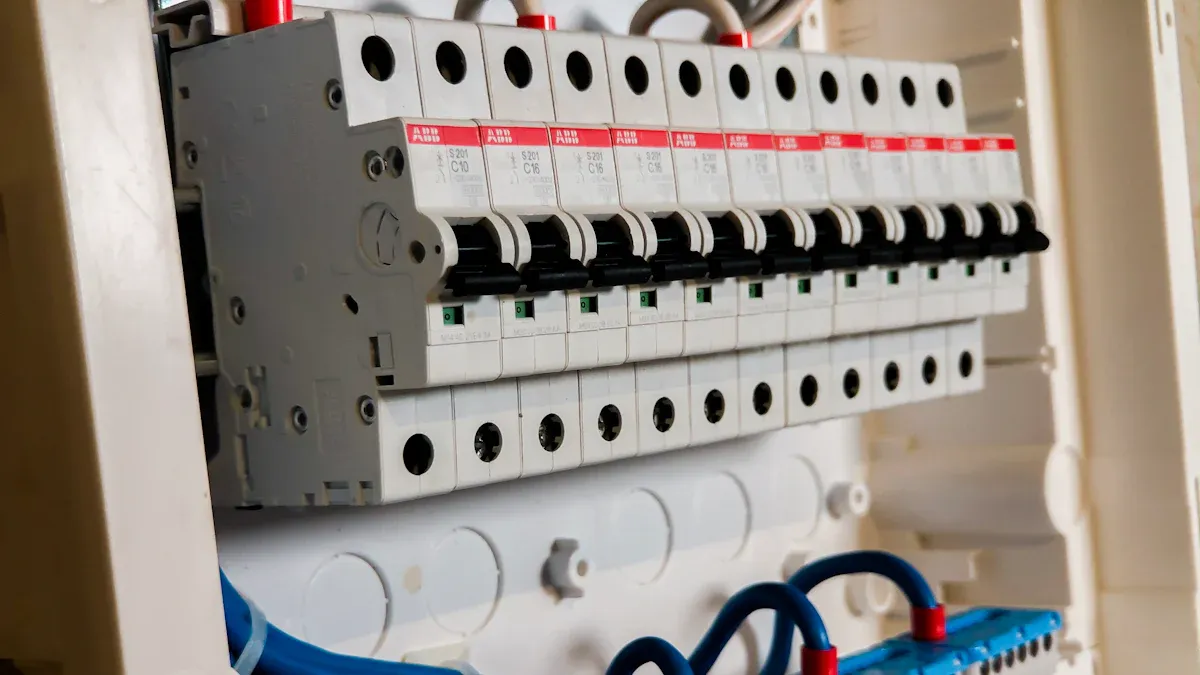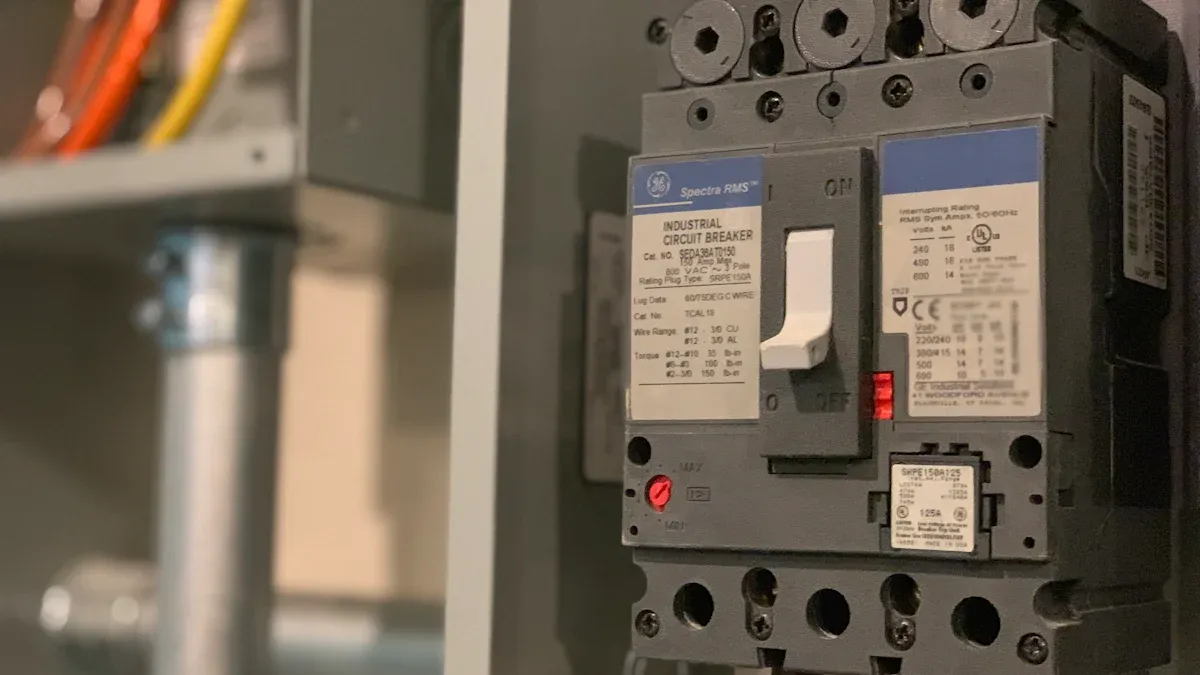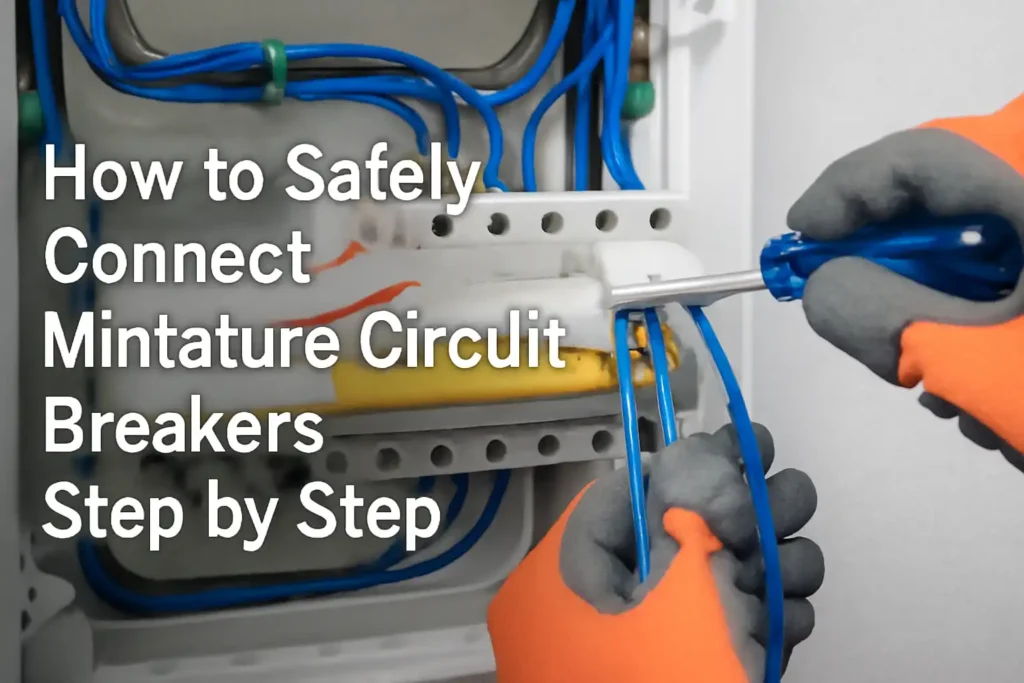lYou want to connect miniature circuit breakers in your home or workshop. Safety comes first, so you need a clear process to avoid mistakes. Taking each step carefully helps prevent accidents and protects your electrical system.
Always turn off the main power before you start any electrical work. If you feel unsure at any point, contact a licensed electrician.
Stay focused and follow each instruction. Your attention to detail ensures a safe and reliable installation.
Key Takeaways
- Always turn off the main power and fully isolate the circuit before starting any work to stay safe.
- Use the right personal protective equipment and tools to protect yourself from electrical hazards.
- Identify the correct MCB type, terminal markings, and polarity to ensure proper and safe connections.
- Follow step-by-step wire connection instructions carefully and double-check all connections before restoring power.
- Test the installation thoroughly and fix any issues promptly to keep your electrical system reliable and safe.
Safety Precautions
Before you connect miniature circuit breakers, you must follow strict safety steps. These steps protect you from electrical hazards and help you avoid costly mistakes.
Power Off and Isolation
Always start by turning off the main power supply. Never trust a circuit breaker alone to keep you safe. Safety studies show that you must use a visible disconnector to fully isolate the circuit. Follow this sequence for complete isolation:
- Switch off the circuit breaker.
- Open the load side disconnector.
- Open the power supply side disconnector.
If you cannot see the disconnection point, use locking devices to prevent accidental power restoration. These steps help you avoid electric shock and keep your workspace safe.
Tools and PPE
You need the right tools and personal protective equipment (PPE) for electrical work. Industry standards require you to use PPE based on a hazard assessment and voltage level. Here are the essentials:
- Hard hat with electrical insulation
- Safety glasses with side shields
- Face shield for arc flash protection
- Insulated gloves and rubber lineman gloves
- Safety shoes with non-conductive soles
- Flame-resistant clothing
Tip: Inspect all PPE before use. Replace any damaged or contaminated items. Training on PPE use and maintenance is also required by safety regulations.
| PPE Type | Standard/Regulation |
|---|---|
| Electrical Safety & PPE Selection | CSA Z462, NFPA 70E |
| Eye and Face Protection | ANSI Z87.1-2020 |
| Head Protection | ANSI Z89.1-2016 |
| Hearing Protection | ANSI S3.19-1974 |
Workspace Preparation
Prepare your workspace before you connect miniature circuit breakers. Keep the area clean and dry. Remove any metal objects or liquids from your work zone. Lay out your tools and PPE so you can reach them easily. Good lighting helps you see wires and terminals clearly. A tidy workspace reduces the risk of accidents and makes your job easier.
MCB Types and Markings

AC and DC Differences
You need to know if your miniature circuit breaker (MCB) is for AC or DC circuits. AC and DC MCBs look similar, but they work differently. AC MCBs break the circuit when the current crosses zero, which happens many times each second. DC MCBs do not have this zero-crossing, so they need stronger parts to stop the current safely. If you use the wrong type, the breaker may not protect you or your equipment. Always check the label or datasheet before you start your project.
Terminal Markings
Terminal markings help you connect wires to the right place. You will see clear labels on the MCB, often printed with laser for durability. These markings show you where to connect the line (incoming power) and the load (outgoing wire). Many MCBs have label spaces so you can mark which circuit each breaker protects. This makes future maintenance much easier.
- Terminal markings let you identify the product and protected lines quickly.
- Label spaces help you keep track of wiring and circuits.
- Laser-printed markings last a long time and resist wear.
- Flexible connection options depend on clear markings for safe installation.
- Contact status indicators and captive screws work with terminal markings to keep your setup safe.
Tip: Always double-check terminal markings before you connect any wires. This step prevents wiring mistakes and keeps your installation safe.
Polarity and Orientation
You must install the MCB in the correct direction. Most MCBs have a line side (power in) and a load side (power out). Some models work either way, but many require a specific orientation. Look for arrows or symbols on the device. For DC MCBs, polarity matters even more. You must connect the positive and negative wires to the correct terminals. If you reverse them, the breaker may not trip during a fault.
| MCB Type | Trip Current Range (times full load current) | Typical Operating Time |
|---|---|---|
| Type B | 3 to 5 | 0.04 to 13 seconds |
| Type C | 5 to 10 | 0.04 to 5 seconds |
| Type D | 10 to 20 | 0.04 to 3 seconds |
| Type K | 8 to 12 | Less than 0.1 seconds |
| Type Z | 2 to 3 | Less than 0.1 seconds |
This table shows how different MCB types respond to overloads. Type B suits homes with low inrush currents. Type D fits industrial machines with high surges. Always match the MCB type to your application for safe and reliable protection.
Connect Miniature Circuit Breakers

Connecting miniature circuit breakers is a careful process. You need to follow each step to make sure your electrical system works safely and reliably. Let’s walk through the main steps together.
Mounting on DIN Rail
Start by mounting the MCB on the DIN rail inside your distribution board. Hold the MCB at a slight angle. Hook the back edge onto the top of the rail. Push the bottom of the breaker until it clicks into place. Some models have a small latch or clip at the bottom. Use a screwdriver to open or close this latch if needed.
Tip: Make sure the breaker sits flat and does not wobble. A loose breaker can cause poor connections or even fall off the rail.
Check that the MCB aligns with the other breakers. This helps you keep your panel neat and makes future work easier.
Line and Load Terminals
You must identify the line and load terminals before you connect miniature circuit breakers. The line terminal connects to the incoming power supply. The load terminal connects to the wire that leads to your devices or outlets.
Look for clear markings on the MCB. Most breakers use “L” or “LINE” for the power input and “LOAD” for the output. Some models use arrows or symbols. For DC breakers, you will also see “+” and “-” signs. Always match the wire to the correct terminal.
Note: If you mix up the line and load, the breaker may not protect your circuit. Double-check the markings before you move to the next step.
Wire Connection Steps
Now you are ready to connect the wires. Follow these steps for a safe and secure connection:
- Choose the Right Wire Size:
Check the MCB’s datasheet for the correct wire size. Most home circuits use 14 AWG or 12 AWG copper wire. Using the wrong size can cause overheating or poor performance. - Strip the Wire Ends:
Use a wire stripper to remove about 10-12 mm of insulation from each wire. Do not nick or damage the copper strands. - Insert the Wire:
Loosen the terminal screw with a screwdriver. Insert the stripped wire end fully into the terminal. For dual-terminal or QuickConnect models, you may have a push-in slot. Push the wire in until it stops. - Tighten the Terminal:
Turn the screw until it feels snug. Do not overtighten, as this can damage the wire or the terminal. For QuickConnect, check that the wire is locked in place. - Check for Secure Connection:
Gently tug on the wire. It should not move. A loose wire can cause arcing or overheating. - Special Note for DC Circuits:
Always connect the positive wire to the “+” terminal and the negative wire to the “-” terminal. DC circuits do not have a zero crossing, so correct polarity is very important.
Callout: If your MCB supports dual wires, make sure both wires are the same size and type. Insert them together and tighten the screw evenly.
Double-Check Connections
Before you restore power, double-check every connection. Go through this checklist:
- Are all wires in the correct terminals?
- Are all screws tight?
- Is the MCB mounted firmly on the DIN rail?
- Did you match the polarity for DC circuits?
- Are there any stray wire strands outside the terminals?
Take your time with this step. Rushing can lead to mistakes that cause electrical faults or safety hazards.
✅ Final Check: Only restore power after you confirm every connection is correct and secure.
You have now learned how to connect miniature circuit breakers step by step. Careful work at each stage keeps your electrical system safe and reliable.
Testing and Troubleshooting
Testing the Installation
After you finish connecting your MCB, you need to test the installation. Start by making sure all tools and loose wires are clear from the panel. Switch on the main power supply. Turn on the MCB and check if it stays in the ON position. If it trips right away, you may have a wiring problem or a short circuit.
Use a voltage tester or multimeter to check for power at the load terminal. The reading should match your supply voltage. If you see no voltage, double-check your connections. You can also press the test button on the MCB if your model has one. This button helps you confirm that the breaker trips as designed.
Many electricians use Statistical Process Control (SPC) to monitor and improve installation quality. SPC uses control charts and trend analysis to spot problems early. If you keep records of your test results, you can see patterns and fix issues before they become serious.
Common Mistakes
You may run into some common errors when installing MCBs. Here are a few to watch for:
- Connecting wires to the wrong terminal (line vs. load)
- Leaving terminal screws loose
- Using the wrong wire size
- Mixing up polarity on DC circuits
- Not fully seating the MCB on the DIN rail
⚠️ Tip: Always double-check each step before restoring power. Small mistakes can lead to big problems.
Troubleshooting Tips
If your MCB does not work as expected, try these steps:
- Turn off the power supply.
- Inspect all wire connections for tightness and correct placement.
- Check for damaged wires or insulation.
- Make sure the MCB matches your circuit type (AC or DC).
- Use a multimeter to test for continuity and voltage.
| Problem | Possible Cause | Solution |
|---|---|---|
| MCB trips immediately | Short circuit, wrong wiring | Check wiring, fix faults |
| No power at load | Loose wire, wrong terminal | Tighten, reconnect wires |
| MCB will not reset | Faulty breaker, overload | Replace or reduce load |
Keep your workspace safe and organized. Careful testing and troubleshooting help you catch mistakes early and keep your electrical system reliable.
You now know how to connect miniature circuit breakers safely. Start by turning off the power and preparing your workspace. Use the right tools and follow each step closely. Double-check every connection before restoring power. If you feel unsure or face problems, contact a licensed electrician. Proper installation keeps you and your electrical system safe. Reliable circuit protection starts with careful work.
FAQ
What should you do if the MCB trips immediately after installation?
If your MCB trips right away, you likely have a wiring error or a short circuit. Turn off the power. Check all connections. Make sure wires do not touch each other. Fix any faults before restoring power.
Can you use any wire size with an MCB?
No, you must use the correct wire size. Check the MCB datasheet for the recommended wire gauge. Using the wrong size can cause overheating or poor performance. Always match the wire to the breaker’s rating.
How often should you check your MCB connections?
You should inspect your MCB connections at least once a year. Look for loose screws, signs of overheating, or damaged wires. Regular checks help you catch problems early and keep your system safe.
Is it safe to install an MCB without professional help?
You can install an MCB if you have basic electrical knowledge and follow safety steps. If you feel unsure or face complex wiring, contact a icensed electrician. Safety always comes first.
The following information may be of interest to you
How to Select and Replace the Right Circuit Breaker
The difference between AC MCB and DC MCB
Circuit Breakers vs Miniature Circuit Breakers: What Sets Them Apart
Comprehensive guide for wiring methods of air circuit breakers



